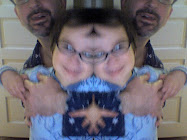(from http://www.pbs.org/art21/artists/murray/ )
Elizabeth Murray was born in Chicago in 1940. She earned a BFA at the Art Institute of Chicago and an MFA from Mills College in Oakland, California. A pioneer in painting, Murray’s distinctively shaped canvases break with the art-historical tradition of illusionistic space in two-dimensions. Jutting out from the wall and sculptural in form, Murray’s paintings and watercolors playfully blur the line between the painting as an object and the painting as a space for depicting objects. Her still lifes are reminiscent of paintings by masters such as Cézzane, Picasso, and Matisse; however, like her entire body of work, Murray’s paintings rejuvenate old art forms. Breathing life into domestic subject matter, Murray’s paintings often include images of cups, drawers, utensils, chairs, and tables. These familiar objects are matched with cartoonish fingers and floating eyeballs—macabre images that are as nightmarish as they are goofy. Taken in as a whole, Murray’s paintings are abstract compositions rendered in bold colors and multiple layers of paint. But the details of the paintings reveal a fascination with dream states and the psychological underbelly of domestic life. The recipient of many awards, Murray received the Skowhegan Medal in Painting in 1986, the Larry Aldrich Prize in Contemporary Art in 1993, and a John D. and Catherine T. MacArthur Foundation Award in 1999. Her work is featured in many collections, including the Walker Art Center, the Museum of Modern Art, the Solomon R. Guggenheim Museum, the Art Institute of Chicago, and the Museum of Contemporary Art, Los Angeles.
This what Mary Rourke wrote in her obit for Murray in the August 16th edition of the L.A. times:
Elizabeth Murray, an artist who painted richly colored, evocative, abstract works after the Minimalist art movement had reduced the art form to a fleet of monochrome canvases, has died. She was 66.
Murray died Sunday at her home in Granville, N.Y. The cause was complications from lung cancer, said Jennifer Joy of PaceWildenstein gallery in New York City, which represented Murray. She had been a resident of Granville and New York City.
(snip)
Many critics noted the cartoon-like quality of Murray's images, which she attributed to her childhood fascination with comics. The playfulness, however, did not disguise ominous undertones, critics observed.
"Murray's paintings have long possessed a clownishness that embraces dark and light, a slapstick joy coexisting with abject terror and rue," wrote reviewer Stephen Westfall in Art in America magazine in 2006.
Such complexities add to the "psychological intensity" of Murray's art, he wrote.
Murray was born in Chicago in 1940 and grew up in a household unsettled by financial insecurity after her father developed a nervous condition and could not hold a steady job. The family eventually moved to Bloomington, Ill., to live with Murray's grandmother.
In 2006 she was given a major retrospective at the Museum of Modern Art in New York City, an honor few women have received.
For many years Murray taught art at various schools, including the University of Buffalo, Bard College near New York City, Yale University and California Institute of the Arts in Valencia.
The following images are from the catalogue of her exhibition in 2003 at Pace Wildenstein Gallery, of which she was represented.

Bowtie
2000
oil on canvas
85"x 77 1/2"
There are of course pros and cons to all writing abouut the creative process because often you need to have your own internal exploration about what the performance or work of art does to you when one experiences it, but I think Francine Prose's prose is very...well, poetic.
"The Four walls of the rectangle cannot possibly contain an art thhat exists on , explores and explodes so many different borders...Elizabeth murray's paintings are anything but lightweight. Far from being humble and timid, they're - given her very particular balance of image and abstraction - confrontational and even pushy in the way they force you against yet another border , a tough demarcation often misidentified as one of gender, or sociology, when in fact that division has more to do with temperament, conscoiusnes, and metaphysics...theseparation between those who can ose themselves in idea, in pure form and abstraction and those who- like Orpheus, like Lot's wife- are sooner or later moved to look back over their shoulders at the raucous and precious world."

Bop
2002-2003
oil on canvas
9' 10"x 10 '10 1/2"
For myself, I cannot help but examine how comical and zany and yet bordering on dangerous these "domestic" images are-
if you turn your on these paintings you might open yourself up to a 2 by four upside the head with a rusty nail!!!Bop!!!!! Now that's a dangerous schtick!!!!!

Hey Madge
2001-2002
oil on canvas on wood
52 1/2 " x 48 "
Hey Madge...is that dishwashing soap you are soaking your hands in??? No, but my ameobas are breaking out of the frame again!!!



No comments:
Post a Comment